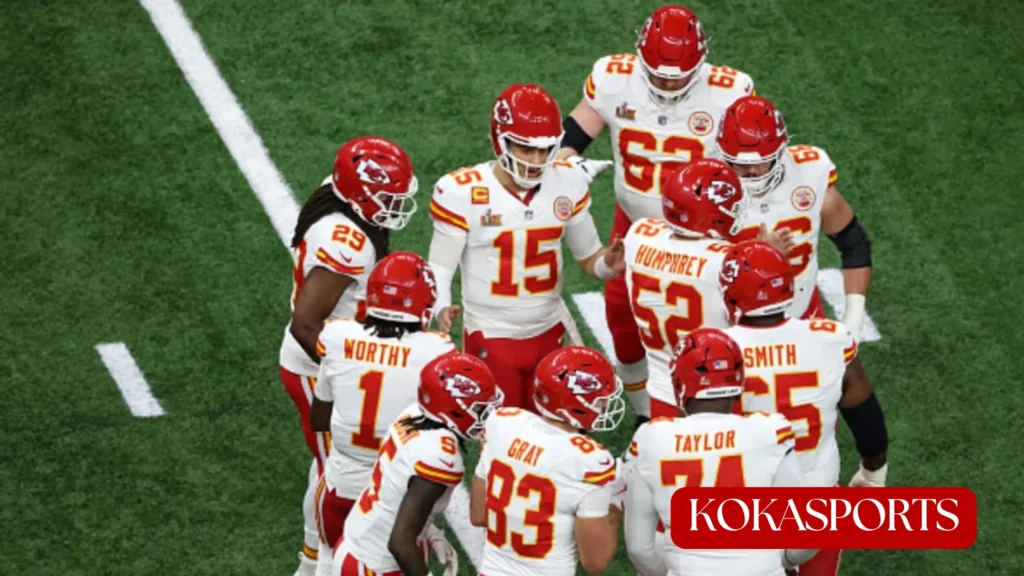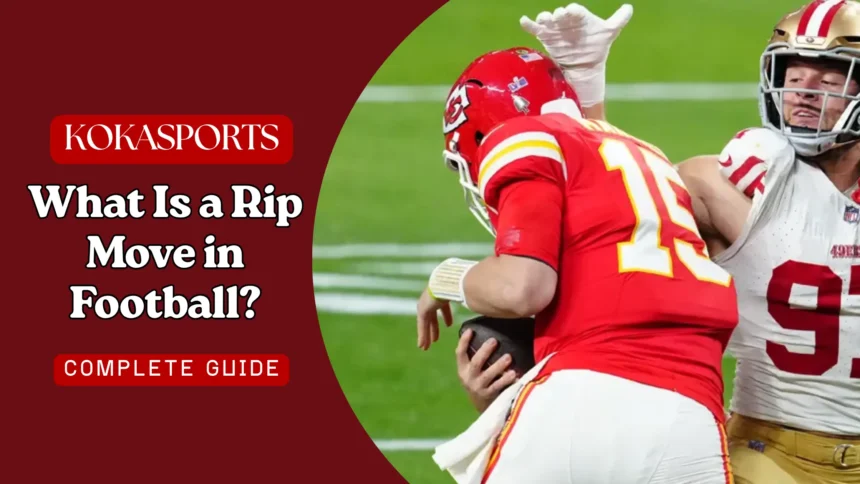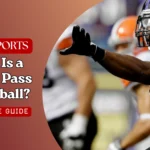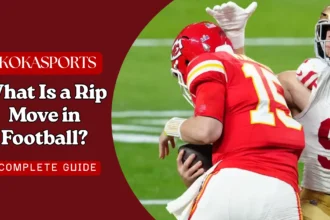The rip move stands as one of the most powerful tools in a defender’s arsenal. When executed properly, this technique allows defensive players to break free from blockers and create game-changing plays. Whether you’re a coach looking to improve your team’s pass rush or a player wanting to dominate at the line of scrimmage, mastering the rip is essential for success.
What Is the Rip Move in Football?
The rip move in football is a block destruction technique where a defensive player uses an upward motion with their arm to disengage from an offensive blocker. Think of it like swimming through water, but instead of a horizontal motion, the defender drives their arm upward and through the gap between the blocker’s body and extended arms.
At its core, the rip combines three critical elements: leverage, explosive power, and precise timing. The defender strikes the blocker with one hand while simultaneously driving their opposite arm (usually the inside arm) upward in a ripping motion. This creates separation and allows the rusher to slip past the offensive player toward the quarterback or ball carrier.
The beauty of this technique lies in its simplicity. Unlike complex moves that require perfect conditions, the rip works in multiple situations. Whether facing a tackle on the edge or battling through the interior offensive line, this fundamental move gives defensive players a reliable way to win their matchups.
Famous players who mastered the rip include:
- Reggie White – Known as the “Minister of Defense,” White combined the rip with raw power
- Aaron Donald – Uses lightning-quick rip moves to dominate interior blockers
- Myles Garrett – Employs the rip as part of his diverse pass rush arsenal
- Nick Bosa – Perfected the rip technique to become one of the NFL’s premier edge rushers
Read More: What Is a Lateral Pass in Football? Complete Guide to NFL and Canadian Rules
Why Defensive Players Use the Rip Move

The rip move serves multiple purposes in defensive strategy. First and foremost, it’s a block destruction tool. When an offensive lineman tries to control the defender with their hands, the rip neutralizes that control by creating an angle where the blocker cannot maintain contact.
Key advantages of the rip:
| Benefit | Description |
|---|---|
| Quick execution | Takes less than a second to complete the motion |
| Minimal contact | Reduces the surface area for blockers to grab |
| Multiple applications | Works against both run and pass rush situations |
| Legal technique | When done correctly, holding will not be called on the offensive player |
| Energy efficient | Requires technique over pure strength |
The rip differs significantly from other defensive moves. The swim move involves a sweeping overhead motion with your arm, while the club requires striking downward on the blocker’s hands. The bull rush relies on pure power to drive the blocker backward. Each has its place, but the rip offers the best combination of speed and effectiveness for most situations.
Teaching the Rip Move: A Coach’s Perspective

Teaching the rip move requires breaking down each component into digestible parts. Football coaches must emphasize that this isn’t about brute force it’s about technique that puts an offensive player in a position that would normally allow them to control the defender.
Step-by-Step Mechanics
Step 1: The Engagement The defender explodes off the line of scrimmage with low pad level. Keep your eyes on the blocker’s chest plate. Your hands should be ready to strike, with elbows bent at roughly 90 degrees. This initial contact sets up everything that follows.
Step 2: The Setup Strike As you engage, strike the blocker with your outside hand (the left arm if rushing from the right side, the right arm if coming from the left). This punch disrupts the blocker’s balance and hand placement. Think of it as creating confusion the offensive player expects you to engage with both hands.
Step 3: The Rip Motion Here’s where the magic happens. As your outside hand occupies the blocker, drive your inside or outside arm (depending on the gap you’re attacking) upward in a violent ripping motion. The motion should start from your hip and explode upward through the blocker’s armpit. Keep your arm tight to your body overextending weakens the move and gives the blocker something to grab.
Step 4: Hip Rotation The rip isn’t just an arm movement. As you drive your arm upward, rotate your hips through the gap. This hip rotation generates power and helps you slip through tight spaces. Your shoulder naturally follows, creating a narrow profile that slides past the blocker.
Step 5: Acceleration Once you clear the blocker, accelerate toward your target. Many young players forget this final step. The rip creates the opportunity, but you must finish with speed to reach the quarterback or ball carrier.
Drills for Mastering the Rip
Practice makes perfect, and the right drill work transforms the rip from a concept into an instinctive reaction. Here are proven drills that defensive coaches use at every level:
The Bag Drill
Set up blocking dummies in a line. The defender approaches each bag, executes a rip motion, and accelerates past. This drill focuses purely on arm movement and hip rotation without the complexity of reading a live blocker. Run this drill at the start of practice to warm up the motion.
One-on-One Matchups
Nothing replaces live repetitions. Pair defensive and offensive players for controlled one-on-ones. Start at 50% speed to emphasize technique, then gradually increase intensity. The blocker should provide realistic resistance while the rusher works on timing and execution.
Mirror Drill
Footwork matters as much as hand technique. In this drill, two players face each other. One player slides laterally while the other mirrors their movement. On the coach’s command, the defensive player executes a rip move. This develops the quick feet necessary to set up the move properly.
The NFL Perspective: Elite Execution
Watch any NFL game, and you’ll see pass rushers use variations of the rip throughout. What separates professional players from amateurs is the subtlety and setup work before the actual rip.
Elite defensive players rarely use a pure rip in isolation. Instead, they combine it with other moves. A defender might start with a speed rush to the outside, forcing the tackle to overextend, then counter back inside with a rip. This combination keeps offensive players guessing and creates better opportunities for the technique to succeed.
Case Study: Aaron Donald’s Interior Dominance
Aaron Donald revolutionized how interior defensive lineman use the rip. At 6’1″ and 280 pounds, Donald uses explosive first-step quickness combined with precise rip timing to defeat much larger offensive guards and centers. His success proves that technique beats size when executed properly.
Watch his highlights on any football video platform like “the world on YouTube,” and you’ll notice how he sets up his rip moves with hand fighting. Donald strikes, creates separation, and then explodes through gaps with his rip before offensive players can recover.
Legal Considerations and Penalties
The rip move is completely legal when executed correctly, but players must maintain awareness of the rules. According to Rule 12 in the NFL rulebook, a defensive charge must avoid certain dangerous actions. Keep your hands away from the blocker’s face mask and neck area. Any contact to these areas results in a penalty, regardless of intent.
Here’s an interesting aspect: when a defensive player uses a rip technique properly, holding will not be called on the offensive player, even in situations that would normally be holding. Why? Because the rip motion naturally puts an offensive player in a position where they appear to be holding, but they’re actually reacting to the defender’s movement. The rulebook recognizes that when the defender’s feet are taken away by their own momentum during a rip, the offensive player isn’t committing a foul the defensive player created the situation.
However, if the blocker clearly restricts the rusher before the rip begins, holding will be called. The key is timing. Once the rip starts and the defender’s body position changes, offensive holding becomes nearly impossible to call.
Common Mistakes to Avoid
Even experienced players make errors when executing the rip. Here are the most frequent problems and how to fix them:
Standing Too Tall: When your pad level rises, you lose leverage. The blocker can easily control you. Keep your knees bent and eyes low. A good tip: imagine you’re ducking under a low doorway as you execute the rip.
Overextending: Some players reach too far with their ripping arm, creating distance from their body. This weakens the move and gives the blocker a target to grab. Keep your arm tight and controlled throughout the motion.
Poor Timing: The rip must coordinate with your footwork. If your feet stop moving, the blocker can recover and re-establish position. As one experienced coach puts it: “Your feet feed the rip if they die, the move dies.”
Neglecting the Setup: The rip rarely succeeds without proper setup. That initial strike with your opposite hand creates the opening. Skip this step, and you’re trying to force your way through a closed door.
Youth Football Considerations
Teaching the rip move to younger players requires patience and modified expectations. In youth football, emphasize body control and balance over power. Young players often try to muscle through blockers, leading to poor technique and potential injury.
Start with slow-motion demonstrations. Have players walk through each step before attempting full speed. Use lighter drill equipment and shorter repetition sets to prevent fatigue, which leads to bad habits.
Most importantly, stress safety. Young players must learn to use his hands or arms properly to avoid dangerous contact. Teach them to keep their head up and eyes focused on the target throughout the move.
Combining the Rip with Other Moves

The best pass rushers use the rip as part of a larger toolkit. Pairing it with other techniques keeps offensive players off balance. A common combination is the rip into swim move sequence. Start with a rip motion, and if the blocker adjusts, immediately transition to a swim to attack the opposite side.
Another effective pairing combines the bull rush with a rip. Drive the blocker backward with power, then execute a rip when they brace and anchor. This sudden change of direction often catches offensive players unprepared.
Conclusion
The rip move represents fundamental football excellence. It doesn’t require exceptional size or strength just dedication to proper technique and countless repetitions. Whether you’re coaching the defensive line at the youth football level or competing in the NFL, this move remains relevant and effective.
For players, commit to daily drill work focusing on hand placement, hip rotation, and acceleration. Study film of elite defensive players to see how they set up and execute their rip moves in game situations. Remember that every sack and tackle for loss starts with winning your individual matchup against the blocker.
For coaches, incorporate rip move training into every practice. Use a variety of drills to keep players engaged while building muscle memory. Emphasize the legal aspects and safe execution to protect both your players and maintain competitive integrity.
Master the rip, and you’ll unlock a powerful weapon that translates to success on every play. The path from learning the basics to executing at elite levels requires patience, but the results more quarterback pressures, more sacks, and more game-changing plays make the journey worthwhile.
FAQs
What is a rip move football?
A rip move in football is a defensive technique where a player drives their arm upward and through an offensive blocker’s arm to break free and rush the quarterback or ball carrier.
What is rip football?
“Rip” in football refers to the motion or move defenders use to gain leverage and escape blocks, often part of a pass rush technique.
How to rip properly?
To rip properly, a defender engages the blocker, lowers their pad level, drives one arm upward under the blocker’s arm, rotates their hips, and explodes past the offensive lineman.
Can you hold on a rip move?
No holding during a rip move is illegal. If an offensive lineman grabs or restricts a defender’s movement while they rip, it results in an offensive holding penalty.



